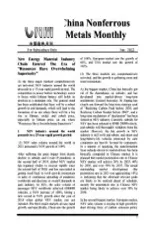Lithium Resource Output Is Hopefully To Grow YOY By 40% This Year In Domestic Market
2022-08-15
Lithium Resource Output Is Hopefully To Grow YOY By 40% This Year In Domestic Market
Lithium price is ascending continuously, and domestic market is accelerating the exploitation of lithium resource. Lithium output is hopefully to grow YOY by 200000 tons, i.e. 41.6%. Zhang Jiangfeng, Vice President of Lithium Branch of China Nonferrous Metals Industry Association (referred to as Lithium Branch), made the aforesaid prediction on China New Energy Materials Industry Chain High End Forum convened on July, 30.
In the first half of year, domestic lithium carbonate output was 204000 tons, and lithium hydroxide output was 118000 tons, totaling 308000 tons of lithium carbonate equivalent (LCE), which basically makes it possible to meet the demands from midstream and downstream enterprises. In 2021, China produced 480000 tons of lithium salt LCE. According to Zhang Jiangfeng, lithium salt output this year in domestic market will exceed 600000 tons. As a key raw material for power battery, lithium resource has a long development cycle, which makes it difficult to handle rapidly the fast growing downstream NEV sales. Supply and demand mismatch has led to continuous rise in lithium price, and lithium price achieved as high as RMB 500000/ton. As of July, 29th, lithium carbonate price in domestic market was RMB 472500/ton, up by 62.9% since the beginning of the year.
China is a big country of lithium salt. However, China highly relies on import for lithium raw material, and the dependence on foreign import in 2021 achieved as high as 65%. Continuously increasing price is driving domestic market to accelerate lithium project development. According to Zhang Jiangfeng, China is rich in lithium resource, but resource grade is far from satisfactory and exploiting is relatively difficult, leading to higher exploiting cost compared to Australia hard rock lithium ore and South Africa salt lake lithium. According to Mr. Zhang, in domestic market, by region, the most important lithium resource exploiting area is Qinghai Province, with an annual capacity of over 100000 tons. Annual output last year was 60000-70000 tons, and hopefully, the output this year will grow by 20000-30000 tons. Lithium salt lake resource in Tibet is high in grade and rich in reserves. However, high altitude and vulnerable ecological environment make it difficult to develop projects there. Salt Lake Co., Ltd., located in Qinghai, announced in May that it planned to invest RMB 7.08 billion in constructing a basic lithium salt integrated project boasting annual capacity of 40000 tons. Constructing cycle of this project is 2 years. After completion, total capacity of the company will double to 70000 tons.
In terms of hard rock lithium ore, according to Zhang Jiangfeng, lepidolite ore in Yichun of Jiangxi boasts abundant prospective reserves, hopefully exceeding 10 million tons. However, its grade is relatively low. The lowest grade up till now in this exploiting project achieved as low as 0.2%-0.3%. Comparatively, another hard rock lithium ore, Spodumene ore, which is being scale exploited, has higher grade, about 1.5% averagely. Additionally, tungsten ore and tin ore contain lepidolite or spodumene, and some enterprises started to extract lithium from these ores. It is estimated that total lithium output in Yichun this year is likely to increase by 30000 tons to 40000 tons. Several power battery manufacturers have concentrated in Yichun. CATL announced in this April that it obtained the prospecting right of a ceramic clay in Yichun at the consideration of RMB 865 million. The ore contains 2657000 tons of accompanying lithium metal oxide. In this May, Gotion High-tech announced that it obtained the prospecting right of a lithium ore in Yifeng at the rate of RMB 460 million. It is estimated that annual production of lithium carbonate of the Company by 2025 will reach 120000 tons. Nevertheless, according to Zhang Jiangfeng, the grade of lepidolite resource in Yichun is relatively low, which will result in stress in environmental protection and energy consumption, and lithium extraction cost. All these will influence sustainable development of this industry.
Additionally, despite the fact that some Chinese companies are partially controlling some overseas lithium projects, China is still playing a weak role in International voice; Australian companies are raising the price of lithium ore, which leads to further fluctuations in market price. Zhang Jiangfeng also indicated that upstream and downstream enterprises in lithium battery chain are competing to enter midstream battery material field, also leading to fiercer competition in material sector and more squeezed space for profit. In terms of demands, Zhang Jiangfeng predicted that demands from China and the whole world for lithium will increase greatly during the “14th Five-Year Plan”. It is estimated that the production and consumption all across the world will grow by 30% each year. Demands from NEV and energy storage for lithium will increase continuously, and we cannot exclude the fact that there might appear a leapfrog growth in a certain period of time. According to data from China Association of Automobile Manufactures, as the biggest NEV market in the world, China saw a total sales volume of 2600000 NEVs in the first half of 2022, YOY up by 120%. According to Chen Shihua, Deputy Secretary-General of CAAM, the data changes based on a certain law monthly, i.e. the closer the end of year is drawing, the higher the sales volume is becoming. CAAM is pretty confident that year-round NEV sales volume will exceed 5000000 vehicles, which means a YOY increase of 42%.
杂志排行
China Nonferrous Metals Monthly的其它文章
- Transformation And Deployments Made By Sino Mine Resource Group In Rubidium, Cesium And Lithium Resources
- Lithium Futures Designs Are Released, Which Designate Main Production And Marketing Areas To Implement Physical Settlement
- HuiYun Titanium Cooperates With Yunliu Mine Company to Invest RMB 6.2 Billion In Lithium Iron Phosphate
- Svolt Energy Invests RMB 17 Billion In Constructing A Lithium Battery Zero Carbon Industry Park In Sichuan
